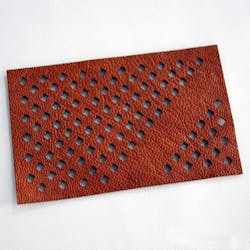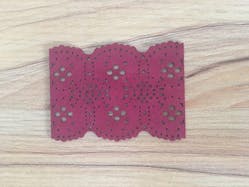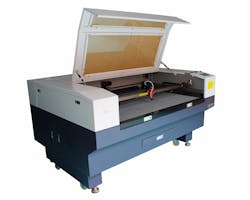STEVEN ZHANG
Along with the progress of society and the development of science and technology, leather products are being more widely used in various applications. Leather products not only create infinite value, but also play an indispensable role in daily life, such as for clothing, shoes, gloves, sandals, fur hats, belts, watch straps, leather cushions, car seats, and steering wheel covers.
Traditional technology for leather processing mostly adopts cutting, embossing, and embroidery machines, which operate at slow speeds and have a high manpower cost with sometimes less than high-quality results. As a consequence, this fundamentally restricts the development of the leather industry.Laser cutting popularity increases
In recent years, because of the wide application and popularization of lasers, leather laser cutting machine use also rose at this time. High-energy, high-power-density carbon-dioxide (CO2) laser beams can process leather rapidly, efficiently, and continuously. Laser cutting machines employ digital and automatic technology, which provides the capability to hollow out, engrave, and cut in the leather industry.
An example is the leather laser cutting/engraving machine by Hunst Laser Technology (Dongguan, Guangdong, China) that provides non-contact, high-speed, and high-precision processing that does not damage the surface of leather and cuts without edge burning. Leather manufacturers favor this machine because it is the best choice for leather production and processing.The laser cutting machine has broken the limits of traditional manual and electric cutting with their slow speed and pattern layout difficulty. The CO2 laser fully solves the problem of unreachable efficiency and waste of materials. The speed of laser cutting is high and the operation is simple, which involves inputting the graphics and piece size to the computer to enable the machine to then cut out the finished product in a non-contact manner.
The advantages of the leather industry adopting CO2 laser cutting are obvious. Compared to the traditional way of cutting, laser cutting is low in cost and consumption, has no mechanical pressure on the workpiece, and the effects of precision and speed are very good. Laser cutting also has the advantages of safe operation and simple maintenance, and the equipment can operate continuously.
How it works
The CO2 laser beam in the leather cutting machine is focused into a small spot so that the focal point achieves a high power density, quickly converting photon energy into heat to the degree of vaporization, forming holes. As the beam on the material moves, the hole produces a narrow cutting seam continuously. This cut seam is little affected by residual heat, so there is no workpiece deformation.
The size of the leather that is laser-cut is consistent and accurate, and the cut can be of any complex shape. Using computer graphic designs for patterns enables high efficiency and low cost. As a result of this combination of laser and computer technology, the user making the design on computer can achieve laser engraving output and change engraving at any time.
Sanjeewa Devasurendra, shoe factory manager at Senara Trading Co. (Nugegoda, Sri Lanka), says the company used to cut shoe molds and engrave patterns with a mold knife, and each style required a different mold. The operation was very complicated, and small and complex pattern designs could not be processed. “Since we bought the laser cutting machine from Hunst Laser Technology, laser cutting has completely replaced manual die cutter cutting. Now, the leather shoes made by laser cutting machine are more delicate and beautiful—the quality and technology have also improved a lot. At the same time, it greatly improves the production efficiency, which is especially suitable for the production of small batch orders or sometimes customized products.”
Capabilities
The leather industry is experiencing a technology change with specialized laser leather cutting machine breaking the low-speed, hard typesetting of traditional manual and electric shears, fully solving the problems of low efficiency and waste of material. By contrast, the laser cutting machine is high-speed and easy to operate, as it only involves entering the graphics and size to the computer. The machine will cut the entire material into the finished product without tools and molds. The use of laser cutting to achieve non-contact processing is simple and fast.
Leather shoe laser cutting machines can perfectly cut synthetic leather, polyurethane (PU) leather, polyvinyl chloride (PVC) artificial leather, leather wool, semi-finished products, and a variety of leather fabrics.
Laser cutting machines accomplish a wide range of applications. CO2 lasers can cut most organic materials such as leather, cloth, plush, PVC, Plexiglas, wood, and other non-metal materials. In terms of shoe materials, cutting and blanking of surface materials, perforation, small flower patterns, and shoe-like paperboards all can be done perfectly. Integral exhaust fans remove fumes from the cutting area.
Founded in 2005, Dongguan Hunst Laser Technology manufactures and supplies laser machines for marking, cutting, and engraving for customers worldwide. The company has always focused on the laser marking, cutting, and engraving machine markets, and they have installed more than 10,000 units of laser equipment.
STEVEN ZHANG ([email protected]) is the sales manager for Hunst Laser Technology, Dongguan, Guangdong, China; www.hunstlaser.com.


